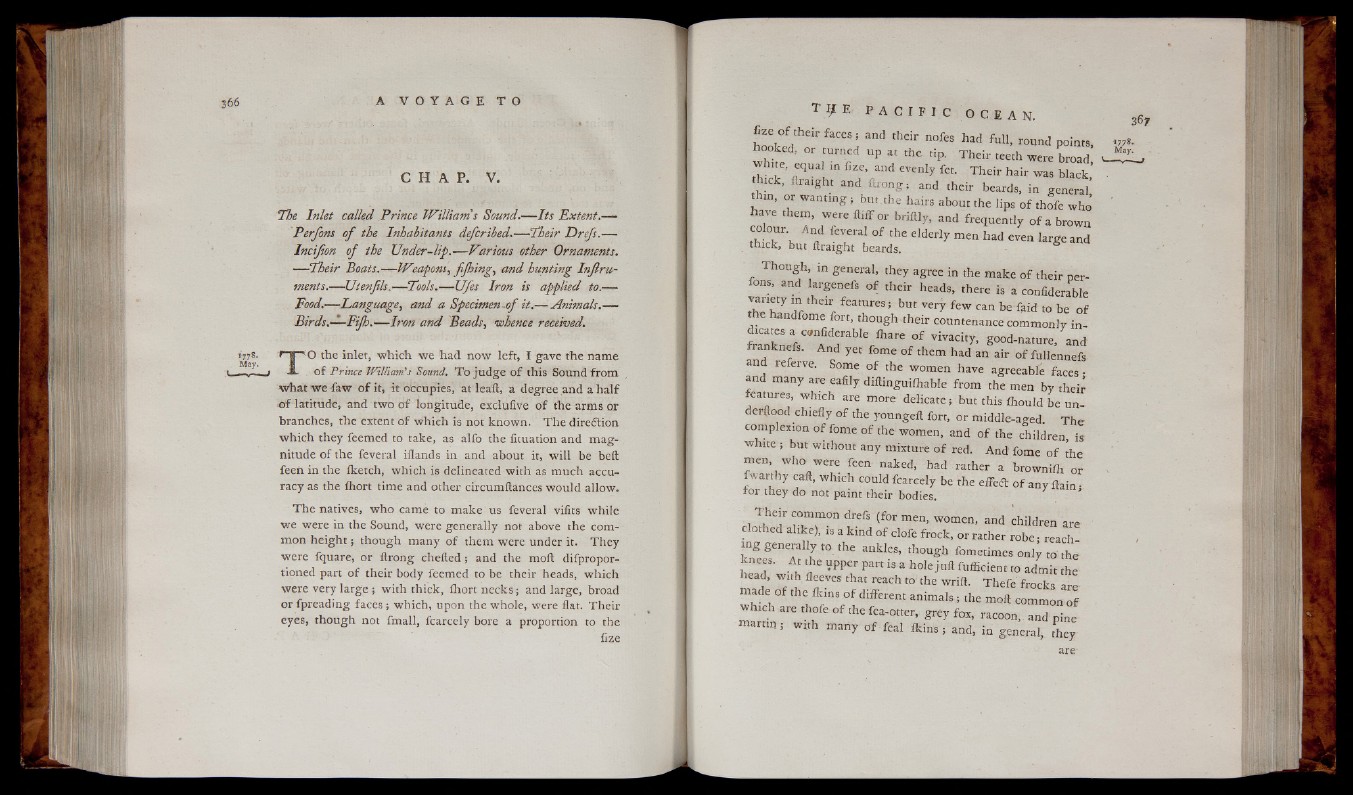
C H A P . V.
The Inlet called Prince Williams Sound.— Its Extent.—
Perfons o f the Inhabitants defcribed.— Their Drefs.—
Incifon of the Under-lip.— Various other Ornaments.
— Their Boats.— Weapons, fijhing, and hunting Injlru-
ments.— Utenfils.— Tools.— Ufes Iron is applied to.——
Food.— Language, and a Specimen-of it.— Animals.—
Birds.— Fijh.— Irm and Beads, whence received.
1778- 1 | vO the inlet, w hich w e had now left, I gave the name
- ■ -i- o f Prince William’s Sound. To ju d g e o f this Sound from
w hat we faw o f it, it occupies, at leaft, a degree and a h a lf
o f latitude, and two o f longitude, exclufive o f the arms or
branches, the extent o f w hich is not known. T h e direction
w hich they feemed to take, as alfo the fituation and m a g nitude
o f the feveral iflands in and about it, w ill be belt
feen in the iketch, w hich is delineated with as much accuracy
as the fliort time and other circumftances would allow.
T h e natives, who came to make us feveral vifits while
w e were in the Sound, were generally not above the common
h e ig h t ; though many o f them were under it. T h e y
were fquare, or ftrong ch e fted ; and the mod difpropor-
tioned part o f their body feemed to be their heads, w hich
were very large ; with thick, fhort n e c k s ; and large, broad
or fpreading faces ; which, upon the whole, were flat. The ir
eyes, though not fmall, fcarcely bore a proportion to the
fize
b c a i and ,h d r ” o l i ” h ld fnl1' W -
hooked, or turned up at the tip. The ir teeth were broad ■ YA
white, equal m fize, and evenly fet. The ir hair was b la ck ’ •
thick, ftraight and ft ro n g ; and their beards, in general
thin, or w an tin g ; but, the hairs about the lips o f thofe who
have them, were ftiff or briftly, and frequently o f a brown
B p . A" d feveral o f « elderly men had even large and
thick, but ftraight beards.
T hou gh, in general, they agree in the make o f their perfons,
and largenefs o f their heads, there is a confiderable
variety in their fea tu re s ; but ve ry few can be faid to be o f
the handfome fort, though their countenance commonly in -
f r a n k Sar C<,nAfidf able fllarC ° f vivacity* good-nature, and
ranknefs. And yet fome o f them had an air o f fullennefs
and referve. Some o f the women have agreeable faces •
and many are eafily diftinguifhable from the men by their
features, which are more delicate; but this ihould be u n -
derftood chiefly o f the youngeft fort, or middle-aged. T h e
complexion o f fome o f the women, and o f the children is
white ; but without any mixture o f red. And fome o f ’the
men, who were feen naked, had rather a brownilh or •
fwar thy caft, w hich could fcarcely be the effe ft o f any ftainfo
r they do not paint their bodies.
T h e ir common drefs (for men, women, and children are
clothed alike), is a kind o f clofe frock, or rather robe; reachin
g generally to the ankles, though fometimes only to the
h e a T ' u T VPPl r part iS a hole juft fufEcienl to admit the
head, with fleeves that reach to the wrift. The fe frocks are
made of the Ikins o f different an im a ls ; the moil common o f
. are thofe o f the fea-otter, g re y fox, racoon, and pine
m a r tin ; with many o f feal Ik in s ; and, in general, they
are